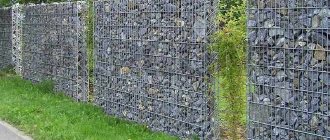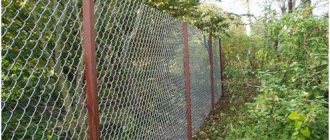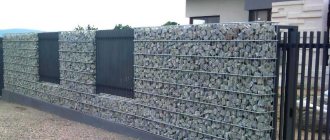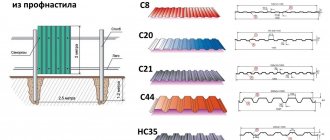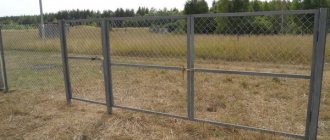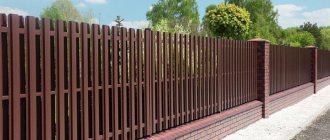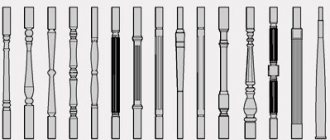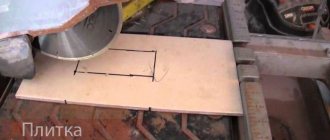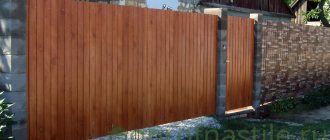A gabion is a structural element made of a dense mesh and filled with bulk materials of various origins: wood chips, stone, glass blocks, broken bricks. When finished, it has amazing resistance to winds, precipitation and ground vibrations. Every day the design of mesh-stone buildings becomes more decorative and fanciful. Anyone with patience and time can build a gabion fence on their property. Classic, modern or urban style is easily created by skillful hands from simple available materials.
History of creation and application features
Written references to gabions go back to the time of Leonardo da Vinci. It was he who proposed filling structures made of dense mesh with stones. When creating the famous San Marco Cathedral in Milan, a gabion foundation was laid for the first time. The cathedral has survived to this day, and this proves that Leonardo was not mistaken.
Later, the unique properties of mesh structures were used on the battlefields by many armies of the world, until military engineers transferred Leonardo’s invention to civilian builders to strengthen slopes, banks and river beds, and protect against storms and hurricane winds. Gradually, gabions turned from earth-protection structures into design elements.
Today, a gabion fence does not claim to be a fortification structure, but combines several advantages:
- an original and quite fresh solution against the backdrop of plank, metal and brick fences;
- simplicity and relative cheapness of materials (cheaper than a solid stone sheet on cement);
- increased class of resistance to erosion and soil shifts;
- lack of foundation and excavation work;
- environmental friendliness.
But the main advantage of Leonardo’s architectural element for our compatriots is the ability to independently build a fence of any height and thickness. To speed up the construction time, you only need the help of family or a few friends. If the liquid bonding solution runs out, you can pause the work and resume it at any time. Weather conditions are also not a hindrance.
Types of gabion structures
Gabion structures, which began to be used quite a long time ago, were initially used as prefabricated fortification structures, including for military purposes. A little later, with their help, they began to strengthen the banks of reservoirs, the slopes of ravines and hills, as well as to develop terraces on sloping areas. And only relatively recently did landscape designers pay attention to the decorative characteristics of gabions and began to actively use these structures to decorate local areas.
Gabions as a retaining wall
Gabion structures are classified according to several criteria, such as:
- geometric shape (flat horizontal structures, which are also known as “Reno mattresses”; vertical volumetric structures - Jumbo boxes; cylindrical gabions);
- the type of mesh used (gabions made of welded reinforcing or twisted wire mesh; in the second case, the cell of the mesh used has the shape of a hexagon);
- type of filler (gabions with stone filler, etc.).
Main types of gabions
For gabion fences, as a rule, vertical volumetric boxes are used, the mesh elements of which are made from pieces of thick wire connected to each other by welding. To further decorate such barriers, you can use cylindrical mesh structures that will serve as decorative pillars. Fences made from gabions often have niches into which garden furniture can easily be built. On the top of such structures, if you pour a layer of fertile soil on them, you can plant a flower garden, plant shrubs or even dwarf trees.
If you decide to make a gabion fence with your own hands, keep in mind that such structures, due to their significant weight, are not suitable for making gates and gates. Meanwhile, choosing entrance elements of the appropriate design for such fences will not be a big problem, since they integrate well with gates and wickets, the design of which uses artistic forging and ordinary rolled metal.
Wickets and gates in gabion structures are fixed on poles pre-installed inside the frames
Using fences made from gabions, rather than traditional barrier structures, you can successfully solve many problems, in particular:
- create barrier structures in the middle of the reservoir or on its shoreline;
- erect fences in areas with difficult terrain;
- build reliable and attractive barrier structures on soft soil.
Required materials and tools
For such construction no special devices are required. Any home craftsman will have the necessary set of tools:
- Tape measure and cord for marking.
- Shovel, hoe, gardener's equipment.
- Crimping pliers or regular pliers.
- Metal scissors.
The use of a welding machine to fasten parts greatly increases the cost of work and does not provide the necessary plasticity of the finished structure. Therefore, wire staples or special stainless steel spirals are more often used to fasten elements.
Welded structure, fastened with a spiral
The required material includes the boxes themselves and their filling. Ready-made sections made from different types of mesh are available for sale. They can be square, rectangular, flat, assembled like cubes or erected as a canvas. But making structures yourself won’t be too difficult either. To do this, first select a metal mesh:
- twisted or welded: the first is good for low and voluminous structures, the second for high fences;
- coated, galvanized or regular: in the latter case, treatment with anti-corrosion paint will be required;
- thickness from 2 to 8 mm depending on the expected load on the walls;
- with a cell 20% smaller than the expected fraction of the filler stone.
Woven mesh with a hexagonal cell
The twisted mesh for gabions differs from the usual chain-link by double twisting of the elements, which makes it more durable and able to hold its shape.
Be sure to paint the welded elements at the joints. This will prevent corrosion and extend the life of the structure.
Having decided on the mesh, choose the filling for it. Glass, plastic, and wooden chibouks are used in this capacity, but the most reliable and beautiful option is still stone. It is permissible to use any types and sizes of it - from crushed stone to pieces of granite, including cobblestones, river and sea pellets.
Different types of stone
When choosing a rock, pay attention to its porosity. In dry climates, it is possible to use hygroscopic materials of sedimentary origin: limestone, gypsum, sandstone, shell rock. In humid regions, volcanic rocks are preferable: basalt, marble, granite, dolomite.
The color and shape of the chipped stones have aesthetic significance and are selected based on the desired effect. An unlimited flight of imagination allows you to create real architectural masterpieces that do not lose their decorative effect over time and are not subject to wear and tear over the course of centuries.
Depending on the operating conditions of the future fence, you may also need: sand, geofabric or film, pipes or reinforcement for structural rigidity. When everything is selected, purchased and delivered to the site, you can begin construction, or rather, assembly of the fence.
We build a fence with our own hands: prepare the tools
In the construction of a fence you will need a number of consumables, in particular:
- brackets for connecting parts of gabions. A simple spiral-shaped wire may also work;
- geotextile material;
- steel pins for fixing the structure in the ground;
- steel braces that perform the function of tying walls located on opposite sides.
Related article:
Gitter mesh fences, chain-link fences. Photos of successful options Photos of fence designs, their features. Gitter mesh for fences. Do-it-yourself chain-link fence. Plastic mesh fencing.
In order to secure work and reduce construction time, it is advisable to prepare additional tools, among which should be the following:
- mount;
- pliers;
- level;
- shovel;
- hammer;
- mittens.
Gabion structures are used not only for the construction of fences, but also for other decorative elements of the site
The main components of the building are stones and mesh. When choosing stones, you should consider the following factors:
- Size of cobblestones. This value can reach up to 40 cm. In this case, the width of the holes in the mesh should be smaller.
- Density and strength of the material. It is necessary that the stone is sufficiently strong and homogeneous.
- Shape of stones. They can be oval, round or quadrangular. Irregularly shaped stones are not suitable for this purpose.
- Resistance to temperature changes and atmospheric influences.
- Aesthetic appearance. Stones perform a decorative function, so they must be attractive in appearance and fit harmoniously into the overall design.
When choosing granite, you should take into account such an aspect as the radioactivity of the stones.
Gabion structures make wonderful decorative barriers
Do-it-yourself welded mesh fence: stages of work
The process of building a fence from mesh and stones does not require any special professional skills or additional knowledge. It includes only four simple steps:
- Preparatory work, consisting of selecting and marking the territory, selecting materials and tools, drawing up an estimate.
- Construction of pillars. In the marked area, holes are dug and supports are installed, which should go one third into the ground. The pillars are installed strictly vertically and fixed with cement mortar. The additional period of time required for the cement to harden should be taken into account.
- The mesh is tensioned by attaching it to the posts with special zinc fasteners. It is advisable to coat the joints with a special anti-corrosion compound.
- Filling with stones. The stones must be laid out by hand, creating a presentable appearance.
The use of stones of different sizes in the gabion also looks very impressive.
Interesting to know! Translated from French, the word “gabion” literally means stones in nets. Thus, the name fully characterizes the design features of the structure. The main advantages of such a fence are the safety of the materials for humans and the absence of the need to care for them.
These are the main stages of constructing a gabion fence. Below we will look at each of them in more detail.
DIY gabion fence: preparatory work
Preparation begins with choosing a location for the future fence. To do this, the surface is leveled as much as possible, cleaned of debris, weeds, including plant roots. Next, calculations are made of all sizes, quantities of materials and an estimate is made according to which the mesh and filler are purchased.
For precise marking, a stretched string or fishing line is suitable. which will help delimit the entire perimeter of the proposed structure. After this, the top fertile layer of soil is removed and a trench of the required size is dug. To prevent grass from growing, the bottom of the pit is covered with geotextiles.
Gabion is excellent for erecting a fence on an uneven surface
The next step is to install the pillars on which the entire structure will be attached. For this purpose, several holes are dug at a distance of 2 m from each other. The supports are immersed one third into the ground. For example, for a two-meter building, they take pillars more than 3 m high, lowering them 120 cm in depth. After this, the supports are filled with cement mortar. It will take at least 2 days for it to harden and completely fix the pillars. The column must have a strictly vertical position. To do this, you need to use a plumb line or level.
Gabion assembly and fencing installation
The box is cut out of mesh fabric using metal scissors or power tools according to individual sizes. The bottom and side walls are fastened in place, and the roof of the structure is mounted at the end of all work, so the next step is to prepare the base for the future fence.
Types of foundations for gabions
When installing a tall structure with low thickness or in case of combination with traditional materials, it may be necessary to strengthen the base and install supports. In this case, it is enough to build a strip foundation and concrete pipes or other load-bearing elements every 2.5 m to stabilize the building. It is permissible to install gabions on a gravel bed and secure them with pillars (metal or concrete).
Structures of great thickness do not need a reinforced foundation. The weight and plasticity of the structure reliably hold the building in one position during ground vibrations and allow the fence to even survive earthquakes. Soil movements during thawing and freezing do not destroy the integrity of the form, leading only to slight displacement and settling of the stones inside the box.
To prepare the base of the fence, it is enough to level the area a little: remove the fertile layer of soil and compact the surface. You can fill the resulting shallow trench with sand. When using fine crushed stone as a filler, it is advisable to deepen the boxes 10–15 cm into the ground. If the stone size is large, it is permissible to erect the structure without burial.
Step-by-step instructions for installing a fence
After preparing the base, care should be taken to ensure that grass roots do not penetrate the sections or grow through the fence. To do this, arrange a small groove (up to 10 cm deep) around the future fence. The resulting recess is lined with geotextile fabric in such a way that the remaining part of the material covers the entire surface under the gabion.
Frame assembly
Step-by-step instructions for further work:
- The bottom of the future gabion is laid on the base, to which the walls are hemmed using special fasteners or simple galvanized wire. The ends are tightly twisted and wrapped inside the structure with pliers.
- If necessary, additional internal diaphragm walls are installed in the finished box. If the length of the gabion significantly exceeds its width, then such jumpers must be made.
- The finished frame, if desired, is additionally strengthened with driven stakes, pipes or fittings with anchor fastening or strapping.
- The sewn and tied gabion is filled with stones in the lower third, trying to select pieces of rock according to size and shape. The denser the stone is laid, the better the characteristics of the finished fence. Small fractions are lightly compacted.
- Every 25 cm, the walls of the mesh containers are fastened together from the inside with wire or a special tie to prevent the walls from expanding outward. It is useful to install a shield on the front side that holds the plane of the fence until the sections are filled with stones.
- Using boxes made of twisted mesh, it is possible to build a high fence by sequentially installing gabions on top of each other. In this case, the bottom of the next tier will be the cover of the previous one.
Fastening the walls together
The product acquires strength only when it is completely ready; at the installation stage, supports and braces may be required to fix the shape. When the gabions filled to one third are fastened, further filling is carried out layer by layer and has several features:
- if the fraction is uneven, then large pieces are placed near the walls, and small pieces are filled in the middle;
- if the entire stone is small, then the filling is done in bulk, but with the obligatory compaction of the layers;
- if the gabion height is more than 1 m, the material is laid in layers with additional fixation of the walls from the inside;
- Screeds are installed when filled to approximately 2/4 and 3/4 of the total volume.
Inside the boxes it is possible to carry out communications to illuminate the fence itself or other wires running along the site. For installation, be sure to use steel pipes hidden in layers of backfill. This way the wires will be safe.
Having filled the gabions to the top, install the lid and secure it tightly. It is worth considering that stones shrink slightly and containers should be filled tightly.
In practice, assembling the frame takes much less time than it might seem from the instructions. Most of the work consists of laying the stones. The higher the fence, the more difficult it is to pack the filler tightly. But if there is an artistic intent and the layers differ in color or shape, then there is no need to rush. The key to a masterpiece's longevity is patiently compacting each layer. The painstakingly created design will not shift over time if the stone settles and is compacted sufficiently.
An external fencing made using this technique not only pleases with its originality and protects from prying eyes, but also serves as a soundproofing barrier and protection from winds. Moreover, unlike masonry, the fence “breathes”; plants planted near it do not overheat in the summer and do not become damp from stagnant moisture and air.
Step-by-step manufacturing instructions
- Choose a gabion design. Select tools and materials. For assembly you will need mesh, filler, wire spirals, staples, steel pins, braces and geofabric. You will need pliers and a special crimping tool.
- Clear and level the installation site. If necessary, you need to prepare the foundation. To do this, you will need to remove ten centimeters of soil, pour a sand cushion, moisten it, compact it and cover it with crushed stone.
- Position the metal boxes or panels in place. Connect them using spirals or staples. The top panel, which serves as a lid, must open freely. If you need to mount a box from a whole mesh sheet, then first mark the bottom, and then the four side sheets. Cut according to the markings. The side panels are folded along the contour and fastened together. Large gabion boxes must be separated by partitions.
- Attach the boxes to the ground or foundation using pins.
- Fill the box halfway with stones. If the height of the gabion is more than a meter, then it must first be filled no higher than one-third.
- Tighten the opposite walls of the gabion with braces or a figure-of-eight wire loop. This will prevent the walls from bulging.
- Fill the rest of the gabion with stone.
- Secure the covers.
It is important to remember that larger stones must be placed on the bottom and against the front walls. Crushed stone, broken bricks, and construction waste are poured inside
To prevent them from falling out, use a layer of geofabric
Crushed stone, broken bricks, and construction waste are poured inside. To prevent them from spilling out, use a layer of geofabric.
Types of structures by shape
The scope of application determines not only the size, but also the variety of shapes of mesh-stone structures. Different types of gabions and main functions:
- Reno mattresses (flat) are used to strengthen river beds, their banks and slopes. They often support massive buildings on floating and unstable soils, and are used as a drainage base for paths and flower beds.
- Box-shaped forms are the most popular, they form supporting walls, fences, and they are used to strengthen dams and dams. Versatility and stability allow the use of rectangular sections with stones in private construction.
- Cylindrical column structures are used as supports on underwater objects; they effectively support steep, crumbling slopes, and act as a bright decorative element in landscape design.
- Non-standard forms can have a wide range of applications from garden sculptures to finishing building facades. Often they are only decoration and do not carry a functional load.
Eco-friendly materials from which building structures are made do not harm the environment in any way and look harmonious on the seashore, on a steep slope and in a flowering garden. Plants love to grow next to such fences, and climbing specimens (ivy, roses) create, leaning on the fence, a beautiful stone-green hedge.
What to consider before starting construction
Prepare materials, equipment, take clear measurements
The gabion group must be strong, stable, safe, and aesthetically beautiful
To meet these criteria, it is important to do the following:
- carry out correct installation
- purchase quality materials
- think over ways to fasten the walls (wire, welding)
- choose the specifics of laying the filler (chaotic filling is unacceptable)
- choose frame, fasteners
It is best to purchase ready-made gabions, which are created in accordance with GOST and TU standards. If you still decide to make the cage walls yourself, carefully study the requirements and strictly adhere to them.
How to make a dog house with your own hands: arrangement of housing in the yard and in the apartment. Drawings, dimensions and original ideas (55+ Photos & Videos) + Reviews
Gabions in landscape design
The peculiarity of gabion fencing is its ability to withstand water flows. You can enclose a site with a fence, even if its border passes through a body of water. It’s not for nothing that gabions are used for lining bridge piers. To strengthen the bank of a river, stream or create your own pond, boxes filled with stones are often used.
The flexibility of the design allows you to reproduce any shape and plan the site according to your own taste. Protective walls for fruit trees or shading of delicate flowers are quickly erected. Unevenness and instability of the soil will not interfere with planning the garden, creating paths, steps, fountains.
Sloping areas can be easily converted into terraces using a time-tested method and modern materials. Gabions prevent soil from shedding and secure flower beds, creating a unique atmosphere of well-groomed and sophistication. The mesh for the boxes is easy to cut and, using your imagination, you can create garden sculptures filled with multi-colored stones, glass, and any available materials.
By shaping the canvas, making slots and niches in it, an ordinary fence is turned into a cozy architectural ensemble, which can be complemented with garden furniture made in the same technique and style. Benches, tables, barbecues are installed on supports made of mesh boxes. And with the help of internal partitions, barbecue areas are created. Simple materials and technology, which previously had only utilitarian uses, today inspire designers, architects and builders to create ever new forms that are easy to build and very difficult to destroy.
How to fill a gabion correctly
When filling the gabion with the selected material, it is recommended to adhere to certain rules, which are as follows.
- The stones should be placed in layers, trying to place them as closely as possible to each other. In wide structures, as mentioned above, large stones are located only at the walls, and the inside of the gabion is filled with sand, pebbles or construction waste, which are wrapped in geotextiles.
- After filling the structure to the middle of its height, install reinforcing lintels.
- After installing the jumpers, the gabion is filled with the material used to the very top.
- Large boulders used to fill the gabion cannot be placed on reinforcing lintels - only on a layer of material of a finer fraction.
- After filling the gabion mesh box, install the next one on it and perform the filling operation in the same sequence until the created fence reaches the required height.
Which gabions are suitable for fences
Original fencing designs can be found in private households. Decorating fences using gabions attracts attention and gives the owners the opportunity to show their creative talent. It is worth noting that when arranging a fence using this technology, the wicket and gates are made of other materials. The gabion is too heavy to ensure the functioning of such sashes. And options with openwork forging or ordinary rolled metal sheets will look quite decent.
Types of fences
There are several types of gabion fences. The varieties of these fences differ in the following characteristics: type of filler, mesh structure and geometric structure.
Taking into account the shape, gabion structures can be in the form of:
- cylindrical structures;
- vertical boxes called “Jumbo box”;
- horizontal flat products called “Renaud matrix”.
Based on the type of mesh box, structures are divided into the following types:
- polygonal wire frame;
- box made of reinforcement rods.
To construct a fence, vertical frames are usually used, made from sections of wire, which are connected using a welding machine. Gabions in the shape of cylinders in this case are decorative supports that decorate the constructed structure.
